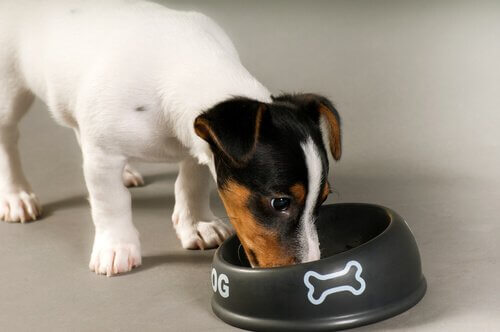Five Ways to Solve Dog Constipation

A dog should have a bowel movement once or twice a day. If this doesn’t happen, or even worse, if the stools are small, hard and sparse when the canine does manage to have a bowel movement, then your animal friend is constipated. Today we’ll tell you how to deal with dog constipation.
If, apart from this problem, your dog seems despondent, lacks appetite, or shows some other sign that something isn’t right with its health, then you should consult your vet. In such cases, it’s very likely that constipation is just a sign of a more serious condition.
Once such symptoms are ruled out, there are ways to improve a dog’s gastrointestinal tract that you can implement without major problems. Here we’ll tell you 5 solutions for dog constipation.

Dog constipation is a common problem. Read on to learn how to cure it.
Ready to take notes?
1. Olive oil
This product provides excellent results in the treatment of dog constipation. It’s a natural option and easy to administer; dogs usually love its flavor too.
If your four-legged friend is having problems defecating, then add one or two tablespoons of extra virgin olive oil to its meal for the next two or three days.
If constipation persists and there are no signs that it’s due to a more serious condition, you can add the oil to the dog’s food permanently.
2. More fiber in the dog’s diet
A diet without the proper amount of fiber contributes to dog constipation.
Currently, high-end commercial food, whether it’s dry or moist, is designed to provide a balanced diet according to the needs of a dog–according to its age, size, development and amount of physical activity.
If you prepare homemade food for your pet, you should make sure that it covers all its nutritional needs in order to prevent constipation or its symptoms from appearing–difficulty with a bowel movement, for example.
In short, the right food, be it processed or homemade, contributes to the regularity of our beloved pet’s gastrointestinal tract.
3. Physical activity
Avoid a sedentary lifestyle, both in humans and pets, in order to ensure better health.
The right amount of physical activity for your dog is closely related to the proper functioning of its intestines. That’s why it’s important that you take time out of your busy schedule to take it out for quality walks, as well as playing games inside and outside the house.
4. Plenty of water
Lack of access to drinking water is one of the main reasons for dog constipation. Make sure that yours always has fresh, clean water at his disposal.
Correct intake of water, in addition to keeping the dog well hydrated, contributes to good digestion.
5. Wet food
Just like cats, dogs get much of the water that their bodies need from their food. And, although 70 percent of natural foods are made of water, dry dog foods don’t have this percentage.
So, incorporate wet food into your dog’s diet to compensate –be it commercial or homemade.

Other reasons that can cause constipation in dogs
Apart from the most common causes of constipation in dogs, there may be other reasons for it. For example:
- As a dog ages, it may have greater difficulty with its bowel movements from time to time.
- Males that have prostate problems tend to have problems with bowel movements. These are usually due to the inflammation of that gland, which may be pressing on their rectum.
- Rectal tumors.
- Problems in their perianal glands.
Furthermore, your vet will be able to offer you great advice on how to help your four-legged friend become regular.
All cited sources were thoroughly reviewed by our team to ensure their quality, reliability, currency, and validity. The bibliography of this article was considered reliable and of academic or scientific accuracy.
- Wilford, Christine, DVM, veterinary consultant. Vet on Call: The Best Home Remedies for Keeping Your Dog Healthy. Rodale Press. 1999. 41.
- Defarges, Alice, DVM, MSc, DACVIM. “Constipation and Obstipation in Small Animals.” Merck Veterinary Manual. https://www.merckvetmanual.com/digestive-system/diseases-of-the-stomach-and-intestines-in-small-animals/constipation-and-obstipation-in-small-animals.